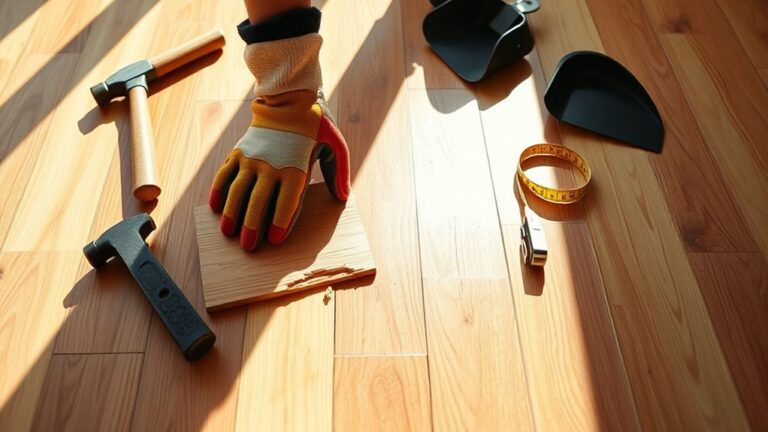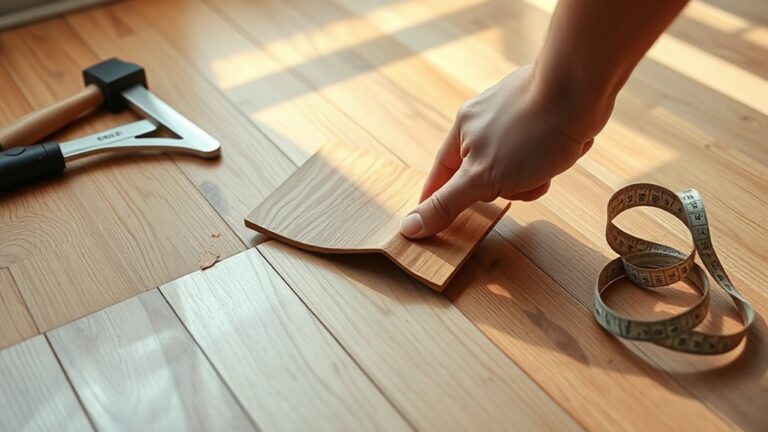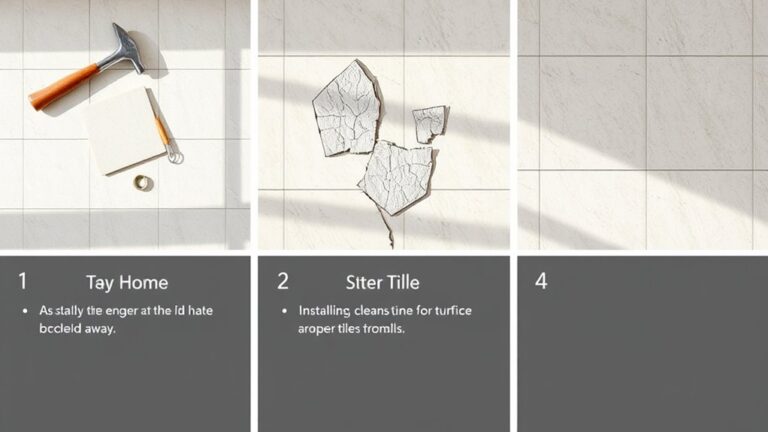To clean laminate floors without damaging them, start by sweeping or vacuuming to remove debris. Use a damp microfiber mop with a gentle, pH-balanced cleaner or a DIY mix of 1 part vinegar to 3 parts water. Avoid soaking the mop to prevent water damage. Mop in the direction of the grain and allow the floor to air dry. For stains, blot spills immediately and use mild detergents as needed. Regular maintenance, like deep cleaning every two weeks, keeps your floors looking great. There's more valuable information ahead to enhance your cleaning routine and protect your floors further.
Understanding Laminate Flooring
When you're considering laminate flooring, it's helpful to know how it's constructed. Laminate flooring consists of three significant layers: the core layer, the decorative layer, and the wear layer. The core layer provides support and is typically made from high-density fiberboard (HDF) or medium-density fiberboard (MDF). Be cautious of low-quality options that may use cardboard, as these can lead to uneven surfaces.
The decorative layer is where the charm lies. It features a printed photographic image that mimics the appearance of wood or stone, giving you the look you desire without the hefty price tag. Above this, the wear layer plays an important role in ensuring scratch resistance, especially in high-traffic areas. This layer protects your floor from daily wear and tear, allowing you to enjoy its beauty for years.
However, maintaining laminate flooring requires some attention. Excessive moisture can warp the core layer, so it's important to avoid using harsh cleaning methods that involve steam or excess water. Instead, stick to gentle cleaning solutions that won't compromise the wear layer. Proper maintenance is crucial; steering clear of excessive moisture and harsh chemicals will prolong the lifespan of your flooring.
Cleaning Frequency and Routine
To keep your laminate floors looking their best, you'll want to establish a regular cleaning routine. Daily sweeping and spot cleaning can prevent dirt buildup, while deep cleaning every two weeks will help maintain their shine and durability. Pay special attention to high-traffic areas, as they may need more frequent care to avoid scratches and damage.
Daily Maintenance Tips
Maintaining the beauty of your laminate floors requires a consistent daily routine that focuses on preventing dirt buildup and preserving their appearance. Start with daily maintenance by sweeping or using a vacuum cleaner with a soft-bristled attachment to remove debris, especially in high-traffic areas. This simple step helps keep your floors looking pristine without risking scratches.
For regular cleaning, aim to vacuum every day or every few days, ensuring you catch any dirt before it settles in. Every two weeks, you should deep clean using a damp microfiber mop. This method effectively picks up grime without oversaturating your floors, keeping them in excellent condition.
Don't forget to implement a monthly routine where you check for any signs of wear and tear. Addressing minor issues early can greatly extend the life of your flooring. By committing to this routine, you'll prevent dirt buildup, stains, and scratches, ensuring your laminate floors remain stunning for years to come. With just a little effort each day, you can enjoy the freedom of beautiful, well-maintained floors without the worry of damage.
Deep Cleaning Schedule
A well-structured deep cleaning schedule is vital for keeping your laminate floors in top shape. Start by committing to a deep clean every two weeks. This helps prevent scratches and dullness, guaranteeing your floors look great. For less frequented spaces, a monthly maintenance routine is sufficient.
Daily spot cleaning and sweeping are essential to avoid dirt buildup, especially in high-traffic areas. Immediately clean any spills to prevent stains and damage the surface. Before you damp mop, always vacuum or dry mop to remove loose debris for a thorough clean.
When you do clean your laminate floors, follow the cleaning instructions carefully. Use the right cleaning products and be mindful of the amount of water you apply; too much can damage the surface. A regular mop works well for this task, but make sure it's damp, not soaking wet.
High-Traffic Area Care
High-traffic areas demand a dedicated cleaning routine to keep your laminate floors looking their best. Daily spot cleaning and sweeping are essential to prevent dirt buildup and maintain the floor's appearance. Using a microfiber mop is ideal for this task, as it efficiently removes dust without oversaturating the laminate surface with water, which can cause damage.
In addition to daily maintenance, aim for a deep cleaning every two weeks. This will help remove accumulated grime and restore the shine of your laminate floors. During deep cleaning, avoid using excessive water, as laminate can warp if it absorbs too much moisture. Instead, use a damp microfiber mop with a gentle cleanser specifically designed for laminate surfaces.
Regular upkeep not only enhances your floor's appearance but also extends its lifespan, especially in zones with heavy foot traffic. By sticking to this cleaning routine, you minimize the need for intensive cleaning, saving you time and effort in the long run. Remember, a little diligence goes a long way in keeping your laminate floors pristine and welcoming!
Essential Cleaning Materials
To effectively clean laminate floors, you'll often find that having the right tools and materials makes all the difference. Using the proper items not only helps you clean laminate floors without damaging them but also guarantees a streak-free finish that you'll appreciate.
Here are three essential cleaning materials you'll need:
- Microfiber Mop: This is your best friend when it comes to cleaning laminate floors. Microfiber mops effectively pick up dirt and dust without leaving excess water behind, which can warp your floors.
- Gentle Cleaners: Always opt for pH-balanced, gentle cleaners specifically designed for laminate flooring. Avoid oil-based products, as they can leave residues and streaks, detracting from your floor's appearance.
- Soft-Bristled Brush: For those stubborn debris pieces, a soft-bristled brush will help you remove them without scratching the laminate surface. This is vital to maintain the integrity of your floors.
Additionally, consider making a DIY cleaning solution. A simple mix of one part white distilled vinegar to three parts warm water, along with a teaspoon of dish soap, can be incredibly effective. Don't forget a bucket for mixing your solutions; this helps prevent the use of overly concentrated cleaners that could harm your laminate.
With these essential materials in hand, you're well on your way to keeping your laminate floors looking their best!
Step-by-Step Cleaning Process
Cleaning laminate floors can be broken down into five straightforward steps that guarantee your floors stay beautiful and well-maintained. Start by removing loose dirt and debris. Sweep or vacuum the area first to prevent scratches during the mopping process. This simple step sets the stage for a more effective clean.
Next, prepare your cleaning solution. Mix 1 part white distilled vinegar with 3 parts warm water, adding a teaspoon of mild dish soap as your cleaning agent for enhanced power. This mixture is gentle yet effective for laminate.
Now, it's time to mop. Dampen a microfiber mop with your cleaning solution, making sure it's not overly wet. Excess moisture can damage laminate flooring, so just a light dampening is ideal. When mopping, always go in the direction of the laminate grain using an overlapping pattern to guarantee thorough coverage. Rinse the mop frequently to avoid spreading dirt around.
Once you've mopped the entire area, allow the floor to dry naturally. If you notice any remaining moisture, follow up with a dry cloth to keep laminate floors looking pristine. By following these steps, you can maintain the beauty of your floors without the worry of damage. Remember, the right amount of detergent in your cleaning solution and proper technique goes a long way in achieving that clean, polished look you desire.
Techniques for Stain Removal
When it comes to stain removal on laminate floors, acting quickly is essential. You should tackle spills immediately with a damp cloth to prevent them from setting. Additionally, using specific methods for different stains will help keep your floors looking their best.
Immediate Spill Response
Spills on laminate floors can be a homeowner's nightmare, but quick action can save your flooring from permanent damage. When you encounter immediate spills, follow these steps to effectively clean up without causing harm:
- Blot the Area: Use a dense microfiber cloth or sponge to absorb the liquid. Be sure not to rub, as this can spread the spill and lead to stubborn spots.
- Create a Cleaning Solution: Mix mild detergent with warm water or combine 1 part vinegar to 3 parts water. Dampen your cloth with this solution—make certain it's not soaked to avoid excess moisture that could damage the laminate.
- Finish Up: After cleaning, check for any residue left behind. Use a dry microfiber cloth to verify the area is completely dry, helping to maintain your floor's appearance.
Effective Stain Removal Methods
Stains on laminate floors can be frustrating, but knowing the right techniques can help you tackle them effectively. For fresh gum or wax stains, start by hardening the substance with ice. Once it's firm, gently scrape it off to avoid damaging the surface. Scuff marks can be easily removed by rubbing a rubber eraser in circular motions, lifting the marks without scratching your floors.
When dealing with paint spills, mix soap and vinegar or use rubbing alcohol on a cotton ball. Remember to blot rather than rub to prevent spreading the mess. For stubborn stains like food or drink, it's vital to act fast. Immediately blot the area with a dense microfiber cloth to absorb the liquid and keep it from seeping into the laminate.
Always test new cleaning solutions on a small, inconspicuous area first. This way, you can verify they won't damage the surface or affect the finish of your laminate floors. By using these effective stain removal methods, you can keep your floors looking their best while maintaining the freedom to enjoy your space without worry.
Scuff Removal Methods
Scuffs on laminate floors can be an eyesore, but they're often easy to remove with the right methods. To effectively tackle these marks without damaging the floor, follow these scuff removal methods:
- Buff with a Microfiber Cloth: For fresh scuffs, take a microfiber cloth and buff the area in circular motions. This method is effective in lifting the scuff without scratching the laminate surface. Just make sure to sweep away any dust and debris first to prevent additional scratches during the process.
- Use a Soft-Bristled Brush: If you're dealing with stubborn scuffs, a soft-bristled brush can provide the necessary friction to lift those marks. Gently scrub the scuff area, being careful not to apply too much pressure, which could damage the floor.
- Mild Soap and Water Solution: For more persistent scuffs, mix a mild soap with water and apply it with a microfiber cloth. After applying the solution, buff the area dry with a clean cloth. This can help restore the shine of your laminate floor while removing any lingering marks.
Best Practices for Maintenance
Maintaining the appearance and longevity of your laminate floors goes beyond just removing scuffs. To keep your floors looking their best, regular sweeping or vacuuming is vital. Aim to do this daily in high-traffic areas to prevent dirt buildup and help maintain shine. A microfiber mop is your best friend when it comes to cleaning; just make sure it's damp—not soaking—since excess moisture can damage the flooring.
When spills occur, clean them up immediately with a damp cloth. This quick action prevents stains and guarantees your floors stay pristine. Avoid using abrasive cleaning tools, as they can scratch the surface and ruin the finish.
Implementing a deep cleaning routine every two weeks can greatly enhance the cleanliness of your floors. Use a mild detergent mixed with water to effectively clean without leaving any residues. This approach not only cleans but also helps in maintaining shine.
Additionally, pay attention to the humidity levels in your home. Proper humidity is essential to preventing laminate expansion or contraction, which can lead to warping or unsightly gaps.
Common Mistakes to Avoid
Many homeowners unknowingly make mistakes that can compromise the beauty and durability of their laminate floors. To keep your floors looking their best, here are some common pitfalls to avoid:
- Using Too Much Water: When mopping, it's essential to avoid soaking your mop. Excessive water can warp and damage the top layer of laminate flooring. Instead, opt for a lightly damp microfiber mop for the best cleaning results.
- Neglecting to Sweep or Vacuum: Before you mop, make sure to sweep or vacuum the surfaces. Skipping this step can allow dirt and debris to scratch the laminate, leading to unsightly damage. Your floors deserve special care, so don't overlook this important prep work.
- Ignoring Spills and Stains: It's easy to let spills slide, but ignoring them can lead to lasting damage. Clean them promptly to prevent discoloration or surface degradation. A quick response can save your floors from irreversible harm.
DIY Cleaning Solutions
To keep your laminate floors looking pristine, using the right cleaning solutions is key. One of the best DIY cleaning solutions involves mixing vinegar and water. Simply combine 1 part white distilled vinegar with 3 parts warm water. This effective solution cleans laminate floors without leaving any residue or causing irreversible damage. For an extra boost, add 1 teaspoon of washing up liquid to the mixture.
Store your DIY cleaning solution in a spray bottle for easy application. This method minimizes the risk of oversaturation, which can harm your flooring. Always remember to test your solution on a small, inconspicuous area before widespread use, ensuring no discoloration or damage occurs.
Here's a quick comparison of different DIY cleaning solutions for laminate floors:
| Solution | Effectiveness |
|---|---|
| Vinegar and Water | Cleans gently and effectively |
| Vinegar, Water & Washing Up | Enhanced cleaning power |
| Commercial Cleaners | May cause irreversible damage |
Regularly using this gentle DIY cleaning solution will help maintain your floor's shine and cleanliness. It's a straightforward way to achieve that fresh look while avoiding harsh chemicals that could compromise your laminate's integrity. With this simple approach, you can enjoy the freedom of maintaining beautiful floors without worry. So grab your spray bottle, mop to remove dirt, and enjoy your clean, gleaming laminate!
Frequently Asked Questions
What Should You Not Clean Laminate Floors With?
When maintaining your laminate floors, you shouldn't use abrasive cleaning tools like steel wool or harsh chemicals like bleach. Avoid common mistakes like excessive water or oil-based cleaners, which can damage protective coatings. For pet messes and stubborn stains, steer clear of non-laminate labeled cleaning products that could harm your floor. Stick to gentle cleaning methods and adhere to maintenance tips to keep your laminate looking great without risking damage.
What Is the Best Way to Clean Laminate Flooring?
To keep your laminate flooring looking great, use effective mop techniques. Regularly sweep or vacuum to tackle pet hair and dirt, and mop with a DIY solution for stain removal and shine enhancement. For cleaning frequency, aim for daily upkeep in high-traffic areas, while deep cleaning every two weeks guarantees surface protection. Always mop in the direction of the grain, and avoid oversaturating to preserve your floor's integrity. Enjoy your beautiful space!
What Is the Best Product to Use on Laminate Floors?
When you're choosing the best product for laminate floors, consider eco-friendly cleaners specifically designed for laminate maintenance. Look for product reviews to find effective stain removal techniques. DIY cleaning solutions, like a vinegar-water mix, can also be great. Pair these with microfiber mops to enhance laminate floor shine without scratching. Always check compatibility before using any new cleaning tools to guarantee they won't damage your floors. Your laminate deserves gentle yet effective care!
Does Vinegar Damage Laminate Floors?
Vinegar's volatile reputation leads many to wonder: does it damage laminate floors? While it can clean, vinegar alternatives are often safer for laminate maintenance. Floor cleaning myths abound, but DIY solutions like mild dish soap offer eco-friendly options without the risk of harm. Prioritize safe cleaning practices to protect your laminate care. Checking product guidelines is essential; remember, a dry mop after cleaning is key to preventing moisture buildup and warping.




